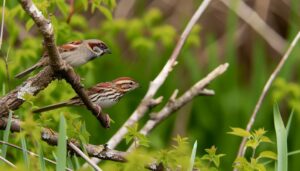Are House Sparrow Toes Short? Anatomy Explained
House sparrows possess elongated toes rather than short ones. This structural adaptation enhances their perching and grasping abilities.
Specifically, their zygodactylous toe arrangement, with a backward-facing hallux, provides exceptional stability and dexterity. This toe configuration supports their perching on various substrates and contributes to their ecological versatility.
Additionally, the well-developed flexor tendon system and curved claws facilitate efficient handling of food resources. These specialized toe features are pivotal for their survival in diverse, urban environments.
To explore the intricate details of their toe anatomy and its evolutionary advantages, further examination is beneficial.

Key Takeaways
- House sparrow toes are elongated to enhance grip strength and perching ability.
- The robust hallux provides support and stability, not necessarily indicating shorter toes.
- Sparrow toes are adapted for precise movements and efficient foraging.
- Urban sparrows may exhibit shorter toes as a selective advantage in city environments.
- Their toes are structured for diverse and complex terrains, ensuring versatility and agility.
Anatomy of House Sparrow Toes
The anatomy of house sparrow toes is characterized by a zygodactylous arrangement, where two toes face forward and two face backward, facilitating their perching and grasping abilities. This digit configuration enhances the bird’s stability and dexterity when maneuvering branches and other perches.
Anatomical studies reveal that the hallux, or backward-facing toe, is particularly robust, providing essential support during perching. The forward-facing toes exhibit a well-developed flexor tendon system, allowing for efficient gripping strength. The phalanges, or toe bones, are relatively short but strong, contributing to the bird’s precise motor control.
Detailed examinations highlight that the integument, or skin, covering these toes is adapted with a textured surface, optimizing traction and minimizing slippage during various locomotive activities.
Comparison With Other Birds
In contrast to the zygodactylous arrangement observed in house sparrows, many other bird species exhibit an anisodactyl configuration, where three toes face forward and one toe faces backward, providing a different set of adaptive advantages for perching and locomotion.
This anisodactyl structure is prevalent in passerines, which includes species like robins and finches. Detailed morphological analysis reveals that the elongation of toes in these species enhances grip strength and stability on varied substrates. Empirical studies indicate that anisodactylous birds can efficiently exploit various perching sites, from slender branches to broad surfaces.
Conversely, house sparrows, with their zygodactylous toe arrangement, demonstrate a specialized adaptation that supports their unique ecological niches, underscoring the diversity of avian evolutionary strategies.
Role in Perching and Walking
The anatomical structure of house sparrow toes, specifically the anisodactyl arrangement, facilitates efficient perching by providing a strong grip on various substrates through opposing toes. Detailed observations indicate that their flexor tendons lock the toes in place, enhancing stability during rest.
Moreover, adaptations in the digital pads and claw curvature play an essential role in walking, enabling precise locomotion on diverse surfaces.
Perching Mechanics Explained
House sparrow toes display a unique combination of anatomical features and muscular adaptations that enable efficient perching and walking. The anisodactyl arrangement, with three forward-facing toes and one backward-facing toe, provides optimal grip and stability.
Flexor tendons, running through the toes, automatically tighten when sparrows crouch, locking the toes around perches. This passive, energy-saving mechanism ensures a secure hold even during rest. Additionally, sturdy digital pads enhance friction against various surfaces, facilitating firm attachment.
Morphological studies reveal that the relative shortness of their toes reduces leverage, thereby decreasing muscular effort required for perching. These adaptations collectively enhance the sparrow’s ability to navigate complex environments, contributing to their widespread success in diverse habitats.
Walking Adaptations Observed
Utilizing a combination of robust muscle coordination and specialized toe morphology, house sparrows exhibit a remarkable ability to shift seamlessly between perching and walking.
The anisodactyl arrangement, featuring three forward-pointing toes and one backward, optimizes both stability and grip. Detailed observations reveal that the flexor tendons, particularly the flexor digitorum longus, play an important role in locking the toes around perches, preventing falls during rest.
Conversely, during terrestrial locomotion, the shorter, stout toes enhance balance and enable rapid, controlled movements. Empirical studies underscore that the unique toe structure not only supports arboreal perching but also allows for efficient ground foraging.
This dual-function adaptation is vital for the house sparrow’s ecological versatility and survival.
Adaptation to Urban Environments
Adaptation to urban environments in house sparrows involves morphological and behavioral modifications that enhance survival and reproductive success amidst anthropogenic influences. These adaptations are pivotal for thriving in cityscapes dominated by human activity.
Key adaptations observed include:
- Morphological Adaptations: House sparrows exhibit shorter toes which may facilitate moving smoothly on man-made surfaces.
- Dietary Flexibility: They exploit a variety of anthropogenic food sources, allowing them to thrive in diverse urban niches.
- Nesting Behavior: Preference for nesting in buildings and structures offers protection from predators and environmental extremes.
- Reduced Fear Response: Habituation to human presence reduces stress and energy expenditure, enhancing overall fitness.
These adaptations underscore the house sparrow’s remarkable resilience and plasticity in urban ecosystems.
Evolutionary Significance
Frequently observed in natural populations, morphological and behavioral adaptations of house sparrows to urban environments provide compelling evidence for the evolutionary processes driving phenotypic plasticity and fitness optimization in anthropogenically altered habitats.
The shortening of toes in house sparrows (Passer domesticus) may be a selective advantage, facilitating better grip on artificial substrates such as metal and plastic.
Empirical studies have demonstrated that urban sparrows with shorter toes exhibit enhanced stability and agility when maneuvering urban landscapes, thereby increasing their foraging efficiency and predator evasion.
This phenotypic shift underscores the influence of urbanization on natural selection, illustrating how rapid environmental changes can shape anatomical traits to enhance survival and reproductive success in modified ecosystems.
Impact on Daily Activities
The anatomical adaptation of house sparrow toes plays a pivotal role in their perching and roosting efficiency. The zygodactyl arrangement allows for a secure grip on various substrates.
Moreover, these toe configurations enhance foraging capabilities by facilitating precise food handling and manipulation, which is critical for their dietary needs.
Empirical studies have demonstrated that these morphological features directly contribute to the house sparrow’s ability to thrive in diverse environments.
Perching and Roosting Efficiency
House sparrow toes, equipped with specialized tendons and muscles, play an important role in optimizing both perching and roosting efficiency, thereby greatly impacting their daily survival and energy conservation. Detailed observations reveal that these anatomical adaptations allow the sparrow to:
- Grip securely: With enhanced tendons, the sparrow’s toes can lock onto branches, providing stability.
- Reduce energy expenditure: The locking mechanism minimizes muscle fatigue during prolonged perching periods.
- Maintain balance: A well-adapted toe arrangement aids in sustaining equilibrium on various substrates.
- Enhance roosting comfort: Efficient toe structures facilitate restful sleep, essential for daily activity and vigilance.
These adaptations not only guarantee the sparrow’s ability to navigate its environment but also significantly contribute to its overall fitness and survivability.
Foraging and Food Handling
Observational studies indicate that the morphology of sparrow toes greatly enhances their efficiency in foraging and food handling, directly influencing their daily routines and nutritional intake.
The relatively short and robust toes provide ideal dexterity and grip, enabling sparrows to adeptly manipulate seeds and small insects. This morphological adaptation allows these birds to access a diverse array of food resources with minimal energy expenditure.
Evidence suggests that the toe structure facilitates precise and rapid movements, important for extracting food from complex substrates. Moreover, the agility afforded by their toe configuration aids in quick changes between foraging sites, thereby maximizing feeding opportunities.
These adaptations collectively guarantee a consistent and efficient intake of nutrients necessary for survival and reproduction.
Observing Sparrow Toes Up Close
Upon close examination, sparrow toes exhibit a remarkable structure characterized by three forward-facing digits and one backward-facing digit, each equipped with sharp claws adapted for perching and foraging.
Detailed observation reveals several critical aspects:
- Digit Length: The forward-facing digits are relatively uniform in length, facilitating a strong grip.
- Claw Structure: The claws are curved and sharp, optimizing the sparrow’s ability to grasp various substrates.
- Flexibility: The backward-facing digit, or hallux, provides additional stability and balance during perching.
- Adaptation: These anatomical features are adapted to the sparrow’s environment, allowing efficient navigation through complex terrains.
Understanding these characteristics underscores the evolutionary adaptations that enable sparrows to thrive in diverse habitats.
Conclusion
Upon careful examination, the distinctive morphology of house sparrow toes discloses significant evolutionary adaptations.
The relatively brief length, when compared to other bird species, highlights their specialized function in urban perching and movement.
This anatomical trait not only enables complex interactions with human-made environments but also impacts daily behaviors and survival tactics.
Observing these small yet vital appendages up close reveals a fascinating narrative of biological ingenuity and environmental symbiosis, prompting reflection on the wider consequences for bird evolution.






